 |
|
Here and There introduces art, artists, galleries and museums around Japan that non-Japanese readers and first-time visitors may find of particular interest. The writer claims no art expertise, just a subjective viewpoint acquired over many years' residence in Japan.
|
|
 |
|
|
 |
 |
Conversations with the Fourth Dimension: Dogu at the Miho Museum
Alan Gleason |
 |
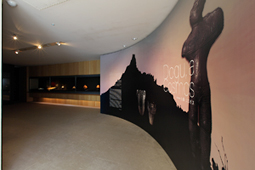 |
|
 |
| Entrance to the Dogu, a Cosmos exhibition. |
|
View of just one of several galleries filled with dogu at the Miho Museum. |
The Jomon culture is a source of endless fascination and speculation in Japan. Spanning the Mesolithic and the Neolithic ages, it occupies a long stretch of the country's prehistory, dating from as far back as 14000 (though this estimate varies) to around 500 BCE. The Jomon lived mostly in east-northeast Japan, but Jomon artifacts have been unearthed as far west as Kyushu. They are popularly regarded as the ancestors of the Ainu, an indigenous people who survive in dwindling numbers in Hokkaido, though recent research suggests that Ainu culture stems from a mix of post-Jomon and Okhotsk culture. About all anyone can agree on is that the Jomon period ended when an influx of people from the Asian mainland brought rice cultivation and metallurgy to southern Japan around the 5th century BCE and began replacing, or eliminating, the Jomon as they pushed farther and farther north.
I was lucky to encounter Jomon culture at a tender age when my family moved to a suburban Tokyo neighborhood that happened to be a major Jomon excavation site. Reconstructed urns and odd shards filled the house of a childhood friend whose father was an archaeologist. For a kid, the astonishing thing was not just the immense size of the vessels -- some would have easily held a five-year-old playing hide-and-seek -- but their ornateness. The Jomon shaped their pottery by hand, not on a wheel, and employed cords and other materials (jomon means "cord-marking") to decorate their work with fanciful designs, which to my youthful eye seemed incongruously rococo for something labeled "primitive."
 |
|
Slab-formed dogu with legs, found in Aomori Prefecture; 22.6 cm, ca. 2100 BCE, collection of Aomori Prefectural Archaeological Artifacts Research Center. Photo by Takeshi Fujimori
|
|
Little did I know it back then, but where the Jomon really outdid themselves artistically was not in the urn department, but in their production of the doll-like figurines known as dogu -- "earth figures." Long treated as archaeological curiosities that played second string to Jomon pottery, dogu didn't really get their props until avant-garde artist Taro Okamoto extolled their virtues in a 1952 essay titled "Conversations with the Fourth Dimension," declaring them artistic marvels "charged with intense religious and magical significance."
Dogu sizes and styles varied dramatically from era to era and region to region. Since the Jomon period was so long (it is divided by scholars into Incipient, Initial, Early, Middle, Late and Final!), and the culture extended over such a large part of the Japanese archipelago, assembling enough examples to provide a comprehensive overview of dogu art would be a daunting task for any curator. Fortunately the staff of the Miho Museum in Shiga Prefecture appears to have been up to the task: the exhaustive exhibition on view till 9 December, Dogu, a Cosmos, is about as all-encompassing as its title implies.
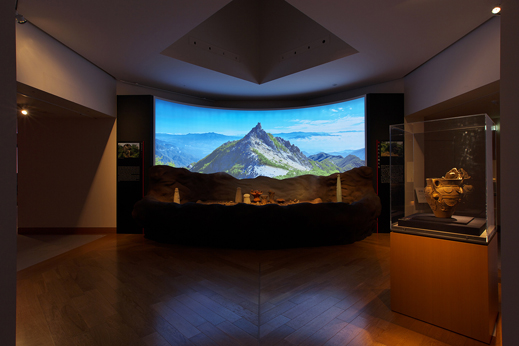 |
Reconstruction of a site full of dogu fragments, urns, stone bars and other items unearthed near the foot of Mt. Jizogatake (pictured) in the Southern Alps of central Honshu. In the case at right is a vessel depicting childbirth, dated ca. 3000 BCE, also from central Honshu.
|
Situated in the Kansai region not far from Kyoto, the Miho is an appropriate venue for a dogu show, since Shiga is one of the rare areas of western Japan where the figurines have been found. Most serendipitously, the oldest known dogu was discovered only two years ago in Shiga: the thimble-sized Aidani dogu dates back to the Incipient Jomon, some 13,000 years ago. Most of them, however, are found to the east and north: in the Kanto region around Tokyo, the mountains of central Honshu near Mt. Fuji, the Japan Sea coast around Niigata, the Tohoku region at the northern tip of Honshu, and parts of Hokkaido.
|
 |
|
The Aidani dogu, discovered in 2010 at Aidani Kumahara, Shiga Prefecture; 3.1 cm, ca. 11000 BCE, collection of Shiga Prefectural Board of Education. Photo by Takeshi Fujimori
|
Dogu are human effigies, many of which appear to be female. One type that boasts huge goggle-like eyes has captured the pop-culture imagination, with UFO enthusiasts like Erich von Daniken arguing that they must depict space-suited aliens. But though experts agree on a more earthbound theory of dogu origin, the purpose of the figures is still a mystery. Noting that the earliest creations were headless, the esteemed archaeologist and dogu expert Tatsuo Kobayashi, who served as supervisor of this exhibition, posits that dogu were images of spirits, not humans. Not until the Middle Jomon -- around 3000 BCE -- did they acquire heads and other human characteristics, including prominent breasts, buttocks, and genitalia, indicating that the function of the dogu gradually changed over time.
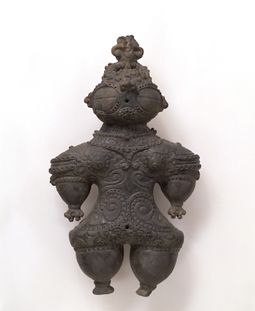 |
|
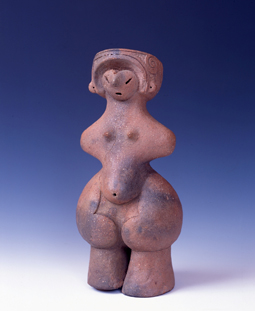 |
| Goggle-eyed dogu, an Important Cultural Property, found in Miyagi Prefecture; 36.1 cm, ca. 1000 BCE, collection of Tokyo National Museum. |
|
The "Jomon Venus," a National Treasure, found in Chino, Nagano Prefecture; 27.0 cm, ca. 3300 BCE, collection of Chino City. |
With the arrival from the mainland of the more technically advanced Yayoi culture, dogu, and Jomon pottery in general, disappeared altogether; by the time of the Kofun period (250-550 CE), the figurines buried in the great tumuli from which that era gets its name were of the haniwa type and bear little resemblance to dogu.
Thanks in large part to Professor Kobayashi's good offices, the Miho Museum has assembled some 320 dogu and other items from 120 excavation sites all over Japan for this handsome show. The Miho itself is a sight to behold -- a vast, airy edifice, perched atop a forested mountain (see the December 2010 issue of "Here and There" for some views of the museum) that looks primeval enough to be a burial ground for Jomon treasure itself.
 |
|
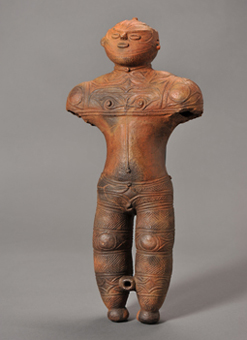 |
| Dogu with palms pressed together, a National Treasure, found in Aomori Prefecture; 19.8 cm, ca. 1300 BCE, collection of Korekawa Archaeological Institution. Photo by Takeshi Fujimori |
|
Hollow dogu, a National Treasure, found in Hakodate, Hokkaido; 41.5 cm, ca. 1300 BCE, collection of Hakodate City.
All images courtesy of the Miho Museum
|
|
|

|
Dogu, a Cosmos: Ancient Clay Figurines |
 |
Miho Museum |
 |
1 September - 9 December 2012 |
 |
300 Momodani, Shigaraki-cho, Koka City, Shiga Prefecture
Phone: 0748-82-3411
Hours: 10 a.m. to 5 p.m. (admission until 4 p.m.); closed Monday (or the following day when Monday is a holiday) and mid-December through mid-March (see museum website for details)
Transportation: 50 minutes by Teisan bus for Miho Museum from Ishiyama station on the JR Biwako Line. Ishiyama is only 13 minutes by train east of Kyoto. |
 |
|
 |
|
|
|
|
 |
Alan Gleason
Alan Gleason is a translator, editor and writer based in Tokyo, where he has lived for 25 years. In addition to writing about the Japanese art scene he has edited and translated works on Japanese theater (from kabuki to the avant-garde) and music (both traditional and contemporary). |
|
|
|
 |
|